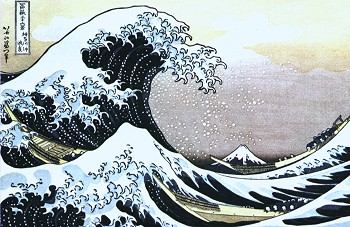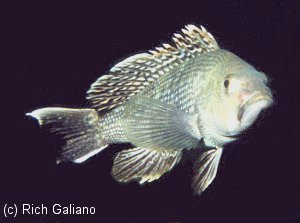Oceanography

Modified from The Challenger Reports (summary), 1895
Human populations through time have often flourished near the sea, partly because of the food resources that can be found there, but also because of the ease of transportation of people and cargo by boats. Observations about various organisms and environments were of course a major part of human activities since the earliest times, since the very survival of early Homo sapiens depended on this knowledge to obtain food and provide defense against dangerous plants and animals.
More: A Brief History of Oceanography ...

With rare exceptions, scuba diving is a bottom-fixated activity. In the region covered in this website, one may encounter many different bottom types, from rocky pinnacles around Block Island to white sands off Cape May to mud and oyster beds in any estuary. This variation is far greater and more interesting than is found in the tropics. Here is some explanation of what bottom compositions are found where and why:
More: Bottom Composition ...

The boundary between land and sea is far from stable and static. Water levels rise and fall, and waves and currents move huge amounts of sediment, rearranging the coastline in ways that are often not compatible with the goals and constructions of man.
More: Coastal Composition ...

We seldom consider the water we dive in, yet it is a fascinating subject in its own right.
Basic Chemistry
Water is an odorless, tasteless, transparent liquid that is colorless in small amounts but exhibits a bluish tinge in large quantities. It is the most familiar and abundant liquid on earth. In solid form ( ice ) and liquid form it covers about 70% of the earth's surface. It is present in varying amounts in the atmosphere. Most of the living tissue of a human being is made up of water; it constitutes about 92% of blood plasma, about 80% of muscle tissue, about 60% of red blood cells, and over half of most other tissues. It is also an important component of the tissues of most other living things.
More: Water Composition ...

Ocean waves are created by wind ( in unique instances, waves may also be created by earthquake, landslide, or other major disturbance, but that does not concern us here. ) The factors in the mechanics of wave creation are wind speed and duration, and fetch.
Fetch is the distance over which the wind acts on the water. The longer the fetch, the greater the wave-building action. Similarly, the greater the wind speed, the greater the wave-building action. Winds are named for the direction they blow from, not to. Therefore, a west wind blows out of the west, toward the east. Predicting wave heights based on wind conditions is even today extremely imprecise - the weather service still gets it wrong about half the time.
More: Wind, Waves & Weather ...
For most of mankind's history, the world's oceans have been used as refuse dumps. Everything from sewage to everyday trash to medical, industrial, and chemical waste has been disposed of in the ocean, or in rivers that flow out to the ocean. In the vicinity of a major urban area like New York, you can bet there has been a lot of waste and dredge dumping, and much of it at sites that are alarmingly close to shore. All ocean dumping was finally banned by the EPA in 1988 after some massive fish kills, but not before many seafloor habitats were contaminated if not outright destroyed. The two major ocean dumping sites that have served the New York area since the mid-1800s are the 12 Mile Dumping Ground and the Mud Dump. Old dumpsites are marked on the charts as yellow areas.
More: Ocean Dumps ...

Here is an abbreviated classification or taxonomy of all the organisms presented in this website, as well as a few others of interest. This is not meant to be a complete listing of all living things, nor even a completely correct one, since these classifications change as new theories come into favor. One should realize that every one of the groupings presented below is a judgment call representing collective scientific opinion, rather than a hard fact.
The classification of living things into groups depends not only on their differences and similarities but also on the degree to which they are studied and understood. For example, lesser-studied types such as mollusks tend to be lumped together into broad classifications, while popular and easily-studied types tend to be divided into fine distinctions. For a prime example of this, pick up any field guide on birds, and see how many Warblers there are in it. Birds are widely considered to be "over-split" - divided into many different species and families that are really not different. Coincidentally, bird-watching is an extremely popular pastime among scientists and laymen alike. Conversely, mollusks are probably "under-split", but then mollusk-watching is no fun at all.
More: Classification of Marine Organisms ...

A fish is defined as a limbless aquatic vertebrate animal with fins and internal gills. There are three living classes of fish:
- Primitive jawless fishes - class Agnatha
- Cartilaginous fishes - class Chondrichthyes
- Bony fishes - class Osteichthyes
These groups, although quite different from one another anatomically, have certain common features related to their common evolutionary origins or to their aquatic way of life. Fish were the earliest vertebrates, and presumably evolved from a group of aquatic lower chordates; the terrestrial vertebrates evolved from fishes.
More: Overview of Fishes ...
An invertebrate is any multicellular animal lacking a backbone. This includes all animal phyla other than Chordata. The major invertebrate phyla include:
- Sponges - Porifera
- Coelenterates - Cnidaria
- Ctenophores - Ctenophora
- Echinoderms - Echinodermata
- Flatworms - Platyhelminthes
- Roundworms - Nematoda
- Segmented worms - Annelida
- Mollusks - Mollusca
- Arthropods - Arthropoda
Invertebrates are tremendously diverse, ranging from microscopic wormlike mezozoans to huge animals such as the giant squid. Approximately 95% of all the earth's animal species are invertebrates; of these, the vast majority are insects and other arthropods. Invertebrates are important as parasites and are essential elements of all ecological communities.
More: Overview of Invertebrates ...

"Higher animals" is a catch-all term for vertebrates other than fish. This is rather self-congratulatory, since the so-called "lower animals" - fishes and invertebrates - are actually the dominant species on the planet, both in numbers and diversity! The four classes of higher animals are:
- Amphibians - class Amphibia
- Reptiles - class Reptilia
- Birds - class Aves
- Mammals - class Mammalia
More: Overview of Higher Animals ...
Algae and plants are similar in that they can produce their own food from nutrients and sunlight by photosynthesis. The main difference between the two is in their complexity. Algae are simple organisms, sometimes unicellular, and even the largest types are relatively simple in structure. True plants, on the other hand, are quite complex, with many specialized structures, even in the smallest types.
Fungi are not plants, they do not produce their own food, but rather feed upon decaying matter. But neither are they animals, so I tacked them on here.
More: Overview of Algae & Plants ...

by Kathy Johnston
Courtesy of Jacques Cousteau National Estuarine Research Reserve
- Home ...
- Dive Sites ...
- Artificial Reefs ...
- Marine Biology ...
- Artifacts ...
- Gear & Training ...
- Blog ...
- Cozumel ...
More: Marine Biology & Ecology ...

